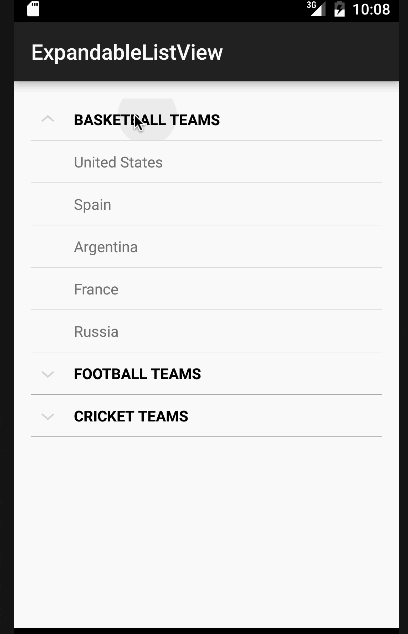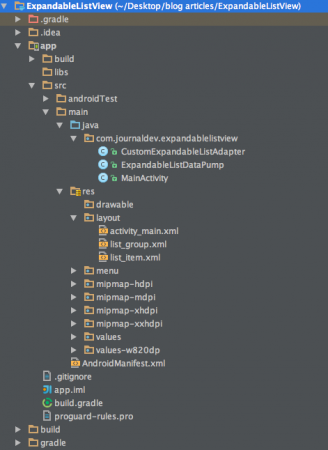歡迎來到 Android ExpandableListView 示例教程。在這個教程中,我們將實現一個ExpandableListView,用於按類別將列表數據分組。這類似於在Android ListView中的菜單和子菜單。
Android ExpandableListView
Android ExpandableListView 是一個顯示項目的垂直滾動的兩級列表。它與 ListView 不同,它允許兩級,即組,可以通過觸摸展開和折疊來查看其相應的子項。在 Android 中,ExpandableListViewAdapter 負責將數據加載到與該視圖關聯的項目中。以下是此類使用的一些重要方法:
- setChildIndicator(Drawable):用於顯示表示當前狀態的指示器,如果子項是組的最後一個子項,將設置狀態
state_last - setGroupIndicator(Drawable):在組旁邊繪製指示器,表示其狀態,即已展開或已折疊。如果組是空的,將設置狀態
state_empty。如果組已展開,將設置狀態state_expanded - getGroupView():返回列表組標題的視圖
- getChildView():它返回列表子項的視圖
該類實現的顯著接口如下:
- ExpandableListView.OnChildClickListener:這被重寫以實現在展開列表中單擊子項時調用的回調方法
- ExpandableListView.OnGroupClickListener:這被重寫以實現在展開列表中單擊組標題時調用的回調方法
- ExpandableListView.OnGroupCollapseListener:用於在組折疊時發出通知
- ExpandableListView.OnGroupExpandListener:用於在組擴展時發出通知
Android ExpandableListView項目結構
- A MainActivity that shows the layout with the ExpandableListView
- 一個ExpandableListDataPump代表列表中的隨機數據並使用HashMap將子項數據映射到相應的組標題
- A CustomExpandableListAdapter which provides the MainActivity with the data from the ExpandableListDataPump class/li>
Android ExpandableListView 代碼
activity_main.xml 佈局包含一個在 RelativeLayout 中的 ExpandableListView,如下所示:activity_main.xml
<RelativeLayout xmlns:android="https://schemas.android.com/apk/res/android"
xmlns:tools="https://schemas.android.com/tools"
android:layout_width="match_parent"
android:layout_height="match_parent"
android:paddingLeft="@dimen/activity_horizontal_margin"
android:paddingRight="@dimen/activity_horizontal_margin"
android:paddingTop="@dimen/activity_vertical_margin"
android:paddingBottom="@dimen/activity_vertical_margin"
tools:context=".MainActivity">
<ExpandableListView
android:id="@+id/expandableListView"
android:layout_height="match_parent"
android:layout_width="match_parent"
android:indicatorLeft="?android:attr/expandableListPreferredItemIndicatorLeft"
android:divider="@android:color/darker_gray"
android:dividerHeight="0.5dp" />
</RelativeLayout>
android:indicatorLeft 是項目指示器的左邊界。注意:我們在 XML 中無法將 ExpandableListView 的 android:layout_height 屬性值設置為 wrap_content,除非父視圖的尺寸已嚴格指定。每個單獨列表的組頭佈局如下:list_group.xml
<?xml version="1.0" encoding="utf-8"?>
<LinearLayout xmlns:android="https://schemas.android.com/apk/res/android"
android:orientation="vertical" android:layout_width="match_parent"
android:layout_height="match_parent">
<TextView
android:id="@+id/listTitle"
android:layout_width="fill_parent"
android:layout_height="wrap_content"
android:paddingLeft="?android:attr/expandableListPreferredItemPaddingLeft"
android:textColor="@android:color/black"
android:paddingTop="10dp"
android:paddingBottom="10dp" />
</LinearLayout>
子項目的佈局行如下:list_item.xml
<?xml version="1.0" encoding="utf-8"?>
<LinearLayout xmlns:android="https://schemas.android.com/apk/res/android"
android:orientation="vertical" android:layout_width="match_parent"
android:layout_height="wrap_content">
<TextView
android:id="@+id/expandedListItem"
android:layout_width="fill_parent"
android:layout_height="wrap_content"
android:paddingLeft="?android:attr/expandableListPreferredChildPaddingLeft"
android:paddingTop="10dp"
android:paddingBottom="10dp" />
</LinearLayout>
ExpandableListDataPump 類定義如下:
package com.journaldev.expandablelistview;
import java.util.ArrayList;
import java.util.HashMap;
import java.util.List;
public class ExpandableListDataPump {
public static HashMap<String, List<String>> getData() {
HashMap<String, List<String>> expandableListDetail = new HashMap<String, List<String>>();
List<String> cricket = new ArrayList<String>();
cricket.add("India");
cricket.add("Pakistan");
cricket.add("Australia");
cricket.add("England");
cricket.add("South Africa");
List<String> football = new ArrayList<String>();
football.add("Brazil");
football.add("Spain");
football.add("Germany");
football.add("Netherlands");
football.add("Italy");
List<String> basketball = new ArrayList<String>();
basketball.add("United States");
basketball.add("Spain");
basketball.add("Argentina");
basketball.add("France");
basketball.add("Russia");
expandableListDetail.put("CRICKET TEAMS", cricket);
expandableListDetail.put("FOOTBALL TEAMS", football);
expandableListDetail.put("BASKETBALL TEAMS", basketball);
return expandableListDetail;
}
}
在上述代碼中,expandableListDetail 對象用於將組頭字符串映射到其相應的子項目,使用一個字符串列表。 CustomExpandableListAdapter.java
package com.journaldev.expandablelistview;
import java.util.HashMap;
import java.util.List;
import android.content.Context;
import android.graphics.Typeface;
import android.view.LayoutInflater;
import android.view.View;
import android.view.ViewGroup;
import android.widget.BaseExpandableListAdapter;
import android.widget.TextView;
public class CustomExpandableListAdapter extends BaseExpandableListAdapter {
private Context context;
private List<String> expandableListTitle;
private HashMap<String, List<String>> expandableListDetail;
public CustomExpandableListAdapter(Context context, List<String> expandableListTitle,
HashMap<String, List<String>> expandableListDetail) {
this.context = context;
this.expandableListTitle = expandableListTitle;
this.expandableListDetail = expandableListDetail;
}
@Override
public Object getChild(int listPosition, int expandedListPosition) {
return this.expandableListDetail.get(this.expandableListTitle.get(listPosition))
.get(expandedListPosition);
}
@Override
public long getChildId(int listPosition, int expandedListPosition) {
return expandedListPosition;
}
@Override
public View getChildView(int listPosition, final int expandedListPosition,
boolean isLastChild, View convertView, ViewGroup parent) {
final String expandedListText = (String) getChild(listPosition, expandedListPosition);
if (convertView == null) {
LayoutInflater layoutInflater = (LayoutInflater) this.context
.getSystemService(Context.LAYOUT_INFLATER_SERVICE);
convertView = layoutInflater.inflate(R.layout.list_item, null);
}
TextView expandedListTextView = (TextView) convertView
.findViewById(R.id.expandedListItem);
expandedListTextView.setText(expandedListText);
return convertView;
}
@Override
public int getChildrenCount(int listPosition) {
return this.expandableListDetail.get(this.expandableListTitle.get(listPosition))
.size();
}
@Override
public Object getGroup(int listPosition) {
return this.expandableListTitle.get(listPosition);
}
@Override
public int getGroupCount() {
return this.expandableListTitle.size();
}
@Override
public long getGroupId(int listPosition) {
return listPosition;
}
@Override
public View getGroupView(int listPosition, boolean isExpanded,
View convertView, ViewGroup parent) {
String listTitle = (String) getGroup(listPosition);
if (convertView == null) {
LayoutInflater layoutInflater = (LayoutInflater) this.context.
getSystemService(Context.LAYOUT_INFLATER_SERVICE);
convertView = layoutInflater.inflate(R.layout.list_group, null);
}
TextView listTitleTextView = (TextView) convertView
.findViewById(R.id.listTitle);
listTitleTextView.setTypeface(null, Typeface.BOLD);
listTitleTextView.setText(listTitle);
return convertView;
}
@Override
public boolean hasStableIds() {
return false;
}
@Override
public boolean isChildSelectable(int listPosition, int expandedListPosition) {
return true;
}
}
此類擴展了 BaseExpandableListAdapter,並且它重寫了基類中的方法以提供 ExpandableListView 的視圖。getView() 將數據填充到具有給定索引的項目視圖中。MainActivity.java
package com.journaldev.expandablelistview;
import android.support.v7.app.AppCompatActivity;
import android.os.Bundle;
import android.view.View;
import android.widget.ExpandableListAdapter;
import android.widget.ExpandableListView;
import android.widget.Toast;
import java.util.ArrayList;
import java.util.HashMap;
import java.util.List;
public class MainActivity extends AppCompatActivity {
ExpandableListView expandableListView;
ExpandableListAdapter expandableListAdapter;
List<String> expandableListTitle;
HashMap<String, List<String>> expandableListDetail;
@Override
protected void onCreate(Bundle savedInstanceState) {
super.onCreate(savedInstanceState);
setContentView(R.layout.activity_main);
expandableListView = (ExpandableListView) findViewById(R.id.expandableListView);
expandableListDetail = ExpandableListDataPump.getData();
expandableListTitle = new ArrayList<String>(expandableListDetail.keySet());
expandableListAdapter = new CustomExpandableListAdapter(this, expandableListTitle, expandableListDetail);
expandableListView.setAdapter(expandableListAdapter);
expandableListView.setOnGroupExpandListener(new ExpandableListView.OnGroupExpandListener() {
@Override
public void onGroupExpand(int groupPosition) {
Toast.makeText(getApplicationContext(),
expandableListTitle.get(groupPosition) + " List Expanded.",
Toast.LENGTH_SHORT).show();
}
});
expandableListView.setOnGroupCollapseListener(new ExpandableListView.OnGroupCollapseListener() {
@Override
public void onGroupCollapse(int groupPosition) {
Toast.makeText(getApplicationContext(),
expandableListTitle.get(groupPosition) + " List Collapsed.",
Toast.LENGTH_SHORT).show();
}
});
expandableListView.setOnChildClickListener(new ExpandableListView.OnChildClickListener() {
@Override
public boolean onChildClick(ExpandableListView parent, View v,
int groupPosition, int childPosition, long id) {
Toast.makeText(
getApplicationContext(),
expandableListTitle.get(groupPosition)
+ " -> "
+ expandableListDetail.get(
expandableListTitle.get(groupPosition)).get(
childPosition), Toast.LENGTH_SHORT
).show();
return false;
}
});
}
}
在上述代碼中,我們已經實現了之前討論的所有接口。為了簡單起見,我們將僅在每次點擊時顯示一個包含項目名稱或組狀態的Toast。但可以輕松修改為執行任何其他操作。以下是我們的應用程序,其中使用了Android可擴展列表視圖。  注意:可擴展列表視圖默認可滾動。這結束了Android ExpandableListView教程。您可以從下面的鏈接下載最終的 Android ExpandableListView項目。
注意:可擴展列表視圖默認可滾動。這結束了Android ExpandableListView教程。您可以從下面的鏈接下載最終的 Android ExpandableListView項目。
Source:
https://www.digitalocean.com/community/tutorials/android-expandablelistview-example-tutorial














